M Moser Associates gets a new office packed with technological innovations that reshape the way their employees work after several years of preparation.
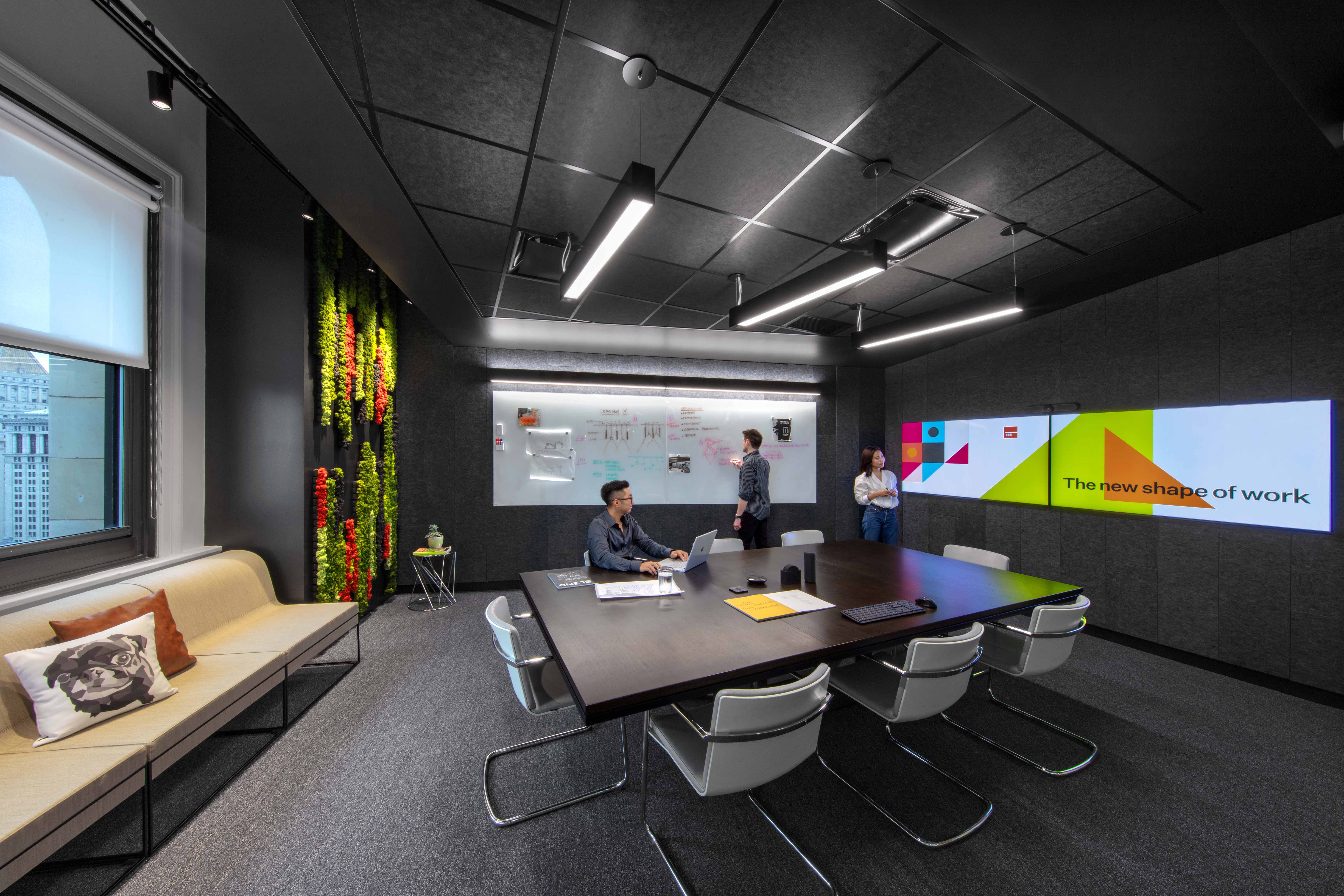
Coming from an open-plan office with assigned seating and benching, it was clear for M Moser that the move would be a catalyst for a dramatic change, not only of location but of the way people work. The change management process was therefore adopted two years before the project began.
…people were encouraged to own all spaces, while simultaneously owning none – adopting free address ahead of the move.
One of the key changes in the new space is enhanced agility and in preparation for the transition, people were encouraged to own all spaces, while simultaneously owning none – adopting free address ahead of the move.
They began to equip each person with a laptop and encouraged movement within the office by setting up some smaller collaborative areas for the team to trial. Desk phones were swapped for mobile devices and encouraged people to use laptops over static monitors.
These changes, coupled with employee workshops, an orientation of the new space types and a dedicated mobile app, created a habitual shift. This steady behavioral transition helped the team resolve small issues one by one, enabling people to gradually adapt to day-to-day life in the new space. By focusing efforts on digital strategy, the team developed a Moser-centric mobile app for the office. This tool enables visitors and staff to book conference rooms, provide feedback, chat with other employees (locally and globally), engage with the community board and even find places for lunch.
When was the project completed?
2018
How much space (SF)?
10,000 SF
Was this new or renovated space?
Renovated space within the landmarked Woolworth Building
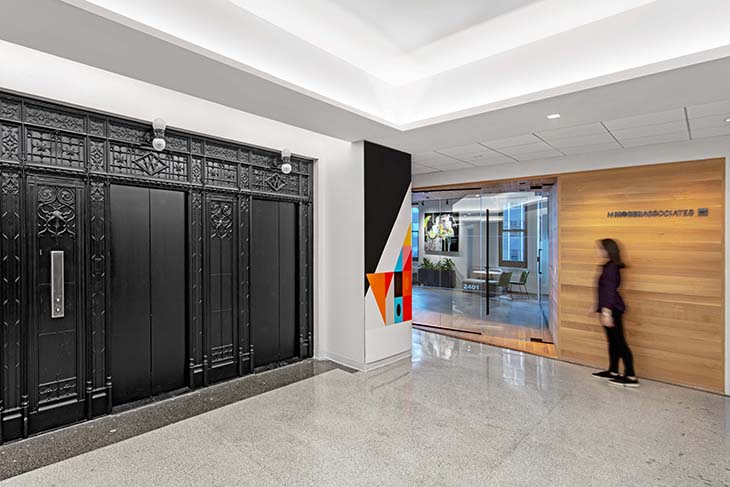
SF per person?
M Moser has designed the NYC office to not only be an agile environment for work but to act as a flexible space to accommodate future growth. While the design provides desks and workstations, we have also accommodated mobile and flexible seating that allows for additional seats for future expansion.
How many employees?
35
What is the average daily population?
25-35
Is there a mobile work or work from home policy? If so, what percent of employees are remote workers?
Our internal technology is cloud-based, enabling us to effectively work anywhere and anytime – additionally creating a seamless and collaborative global team. As we are a wireless office, we are able to work from home or coffee shops in between meetings. There is no formal policy in place, however. We do urge our team to work from home if they are sick and have deadlines, but for the most part, we assemble in the office every day and have not lost any of our staff to remote working. Our aim is to create environments that are mobile and flexible but that bring people together to collaborate and interact in order to gain new insights, ideas, and agile working.
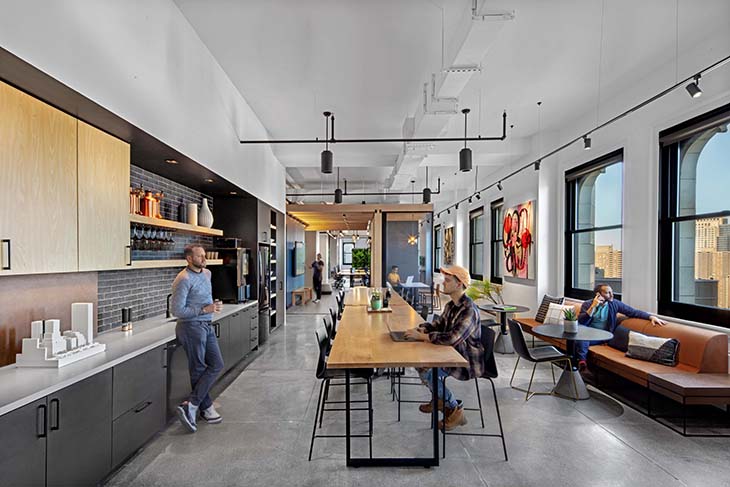
Describe workspace types.
M Moser NYC is an open-plan, free address office.
What kind of meeting spaces are provided?
The office has five meeting rooms – one large conference room for up to 20 people with a feature wall of preserved moss showcasing Moser’s brand colors, two phone booths/focus rooms, one small meeting room for 2-4 people, one medium-sized conference facility with sit/stand capabilities, and one large “living room”/lounge with armchairs, sofa, and a non-tech room for innovation and “think tank” or collaboration meetings.
All meeting rooms include white/blackboards for storyboarding, etc. Additionally, the “innovation alley” separating the pantry from the workspace acts as a meeting area with a whiteboard and 86” touch-screen monitor.
In the back of the office, we have included a VR lab with a mobile 86” touch-screen monitor where the teams are able to host clients and walk them through their newly designed space. Additionally, the VR lab acts as a potential pilot space for clients, if needed, and has been a designated quiet space throughout the week – conversation and collaboration are discouraged in the space, signaling the need for “heads down”, focus time for any staff choosing to sit there.
What other kinds of support or amenity spaces are provided?
MLQ studio (“Mind, Lounge, Quiet”) is a sound-proof room that acts as a mother’s room with a mini-fridge, sofa, and sink for new mothers, but can simultaneously be used as a video/photo studio, meditation, or prayer room. We have included a variety of collaboration zones and furniture solutions that act as additional meeting spaces or work zones.
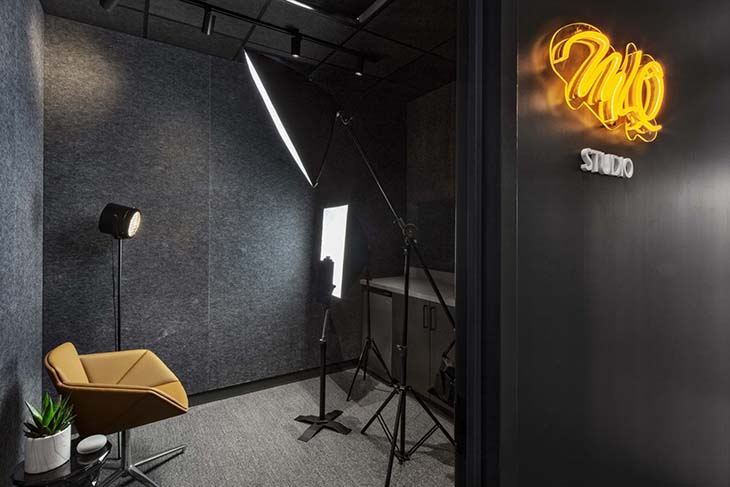
M Moser’s pantry is also unique in that it is the welcome space of the workplace. The office does not have a reception desk or a formal reception. Instead, we have replaced reception with a human connection in the form of our Community Manager who brings our brand and culture face to face with our clients and visitors. The pantry not only enables our staff to take a break from the workplace for lunch or meals but additionally provides an alternative work point as a type of café space or coffee shop, as well as an informal meeting area and town hall space for All-Hands gatherings or events.
Has the project achieved any special certifications?
The M Moser Associates NYC office is in the process of becoming LEED certified and should receive proof of certification by the end of the summer. The office has been designed to meet WELL Platinum Certification and is in the process of submitting certification, with the hopes to be certified by the beginning of 2020.
What are the projects location and proximity to public transportation and/or other amenities?
M Moser is located within the Woolworth Building in downtown Manhattan. The financial district was historically the location of many high-profile architecture firms ahead of the 2008 financial crisis, and with a looming lease ending, we focused our move from Gramercy to the downtown area. The Woolworth Building was a specific target as it was considered an innovation in its time – and still considered to be today. We wanted to create a challenge for ourselves to show everyone what is possible even in a historical and landmarked building. Building a new space or leasing space in the newest development isn’t always necessary to create a future-proof, technology-driven, and innovative workplace.
We are located right by the 9-11 memorial, One World Trade Center, directly across from a park (City Hall Park) for our staff to have meetings or collaborate in green space, and flanked by the A-E-C, 1-2-3, 4-5-6, N-R-W, and the PATH trains. There are high-end restaurants, healthy food options, gyms, and shopping nearby.

What is the most unique feature of the new space?
The new office in NYC embraces a wireless approach, where the staff has access to rechargeable mobile battery packs to further enhance mobility. Equipped with a VR Lab to work through design solutions, a 3D printer to prototype architectural elements, and an Innovation Lab to strategize with design teams and clients, the space facilitates a future-focused approach to creativity. Additional technology upgrades include hedge-fund connection-level 3GB Wi-Fi, a fully cloud-based network, a U Rack server for space optimization and a biometric fingerprint reader to mitigate key card entrance.
By focusing efforts on the digital strategy, the team developed the New Assembly ™ app – “a new way to assemble”. This tool enables visitors and staff to book conference rooms, provide feedback, chat with other employees (locally and globally), engage with the community board and even find places for lunch.
Additionally, we have created a unique co-working office that has simultaneously been a start-up incubator for small businesses, such as fashion and music technology, as well as a co-working partnership with a global engineering company. Additionally, M Moser’s NYC office acts as a client-focused co-working space for visiting partners and clients looking to trial a new way of working, as the firm is able to create and facilitate a pilot space in the office. M Moser uses this co-working opportunity as a way to invite new ideas and ways of working with which M Moser team can interact, learn, and incorporate into their day-to-day workplace – in turn, inspiring innovation within the M Moser team.
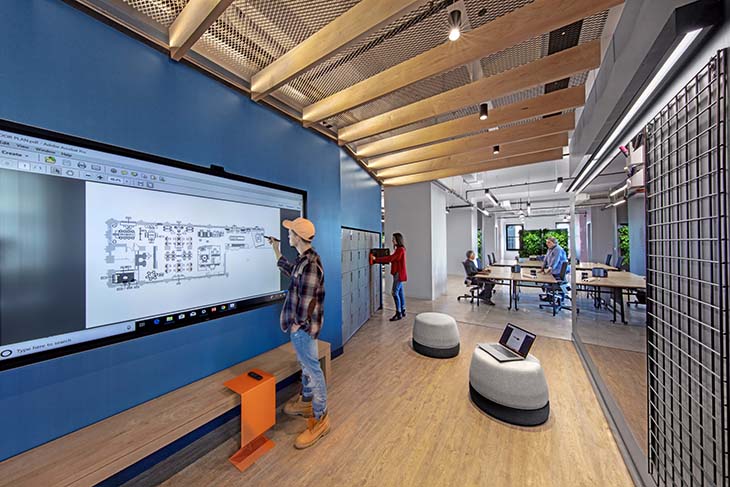
Since the company relocated to a new space, what was the most difficult aspect of the change for the employees?
For our team, the only difficulty in change came from learning individual commute changes. Our strategy team began the change management process nearly two years ahead of our planned move. Starting with small changes such as removing all trash cans to encourage movement around the office – while a minimal change, took nearly a month or so to become a new habit within the workplace.
How did the company communicate the changes and moves?
The company began by holding monthly “state of the unions” on the move and lease expiration, as well as where they were looking to lease space in the city.
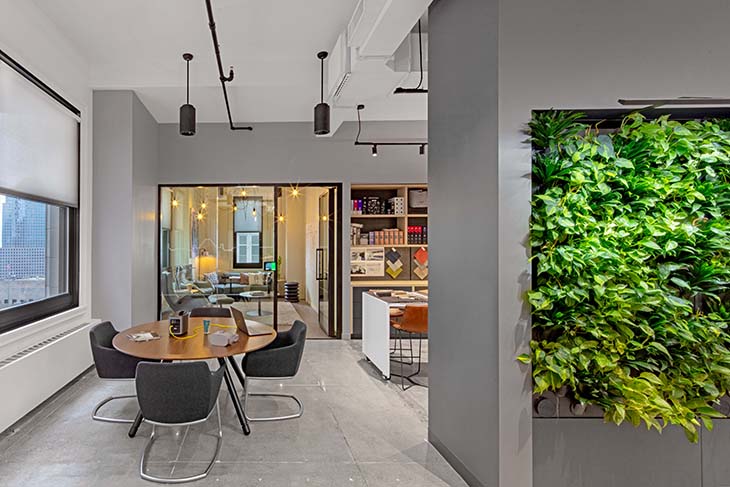
Were there post-occupancy surveys?
The design of the new office was based on occupancy surveys of the old workplace and workplace strategy findings regarding the needs and desires of the staff. Six months into the new workplace in the Woolworth Building the strategy team performed a post-occupancy survey over the course of 2-3 weeks.
What were the most surprising or illuminating or hoped-for results?
The results were very in line for what we hoped and designed the space for – the staff moves about the office completely agile and flexible. We have reorganized furniture for a variety of needs and have invited co-working groups without any issues. Surprisingly, we found there was a desire for more heads-down, focus space – though a couple of rooms, as well as booths, were provided for this reason, they were always booked and difficult to reserve. To remedy this situation, we have turned the VR lab into a multi-purpose space and added a room booking system to the area. During the week from 8 am – 4 pm, the space acts as a “quiet area” or library, signaling to all that the person working in the area is not to be disturbed.
Tell us more!
Architects/Designers: M Moser Associates
#NewYork_MMoser #livinglab


